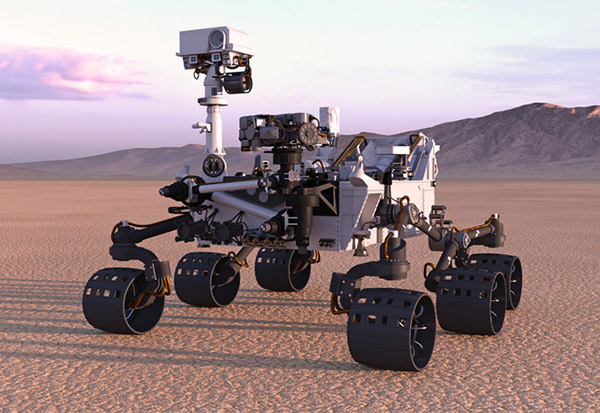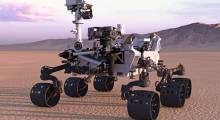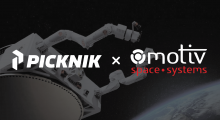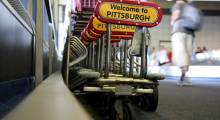Ever since Elon Musk made the controversial claim that he could send 1 million people to Mars by 2050 in January 2020, many space exploration pundits and scholars have tried to identify the achievability of that statement.
From collecting samples from the moon's surface to setting up a colony on Mars, it turns out that humans alone aren't enough because of adaptability and risk factors. Not only is choosing a robot for space missions a safer way, but it’s also at least 50x more economical.
The Apollo program, which was completed successfully in 1972, cost the U.S. $25.4 billion back in 1973, which is equivalent to about $165 billion in 2021 dollars. However, if we look at NASA's Perseverance Rover, which took flight in July 2020, it had a total expenditure of around $2.5 billion to $2.7 billion.
What we should also notice here is that the Apollo program was to explore the moon. Hence, the distance in case of the Apollo mission was 384,400 km (238,800 mi.), while in case of the Perseverance rover, Mars is a minimum of 54.6 million km (33.9 million miles) away.
If we compare the given metrics, the cost per kilometer for Apollo was close to $400,000, while for the Perseverance rover, it was less as $49.
Technology has evolved much since the Apollo program, and conducting a crewed mission to the moon today could cost less than it did back then. Even so, manned missions cannot be conducted without essential supplies like oxygen, water, and food, which eventually add to the weight of the spacecraft and thus make the trip costlier.
The biggest and the most apparent advantage of having a rover on board rather than a human is that no one’s life is on the line, and all the possible catastrophes en route are just visible on a big screen at the control station. Hence, the goal of innovators in space exploration will always be to move the needle more towards robotics and automation and reduce direct human intervention as much as possible.
Where are robots applied in space?
The number of locations to explore in space is vast, but the operations that robots need to perform are very much alike in every case. Hence, based on the type of operations they perform, space robots can be widely categorized into two categories.
Remotely operated vehicles: ROVs or landers can perform operations like terrain exploration, collecting samples, and reconnaissance. They can also take pictures and detect changes in the environment like variations in temperature. NASA’s Curiosity and Perseverance are examples of rovers.
Space manipulators: These are basically robotic arms that assist in maintenance, repair, assembly, and inspection. These are also used in loading/offloading of objects within the space shuttle. Three of the most widely known space manipulators are:
- Canadarm1—14.7 m (48.8 ft.) long arms
- Canadarm2—17.5 m (57.7 ft.) long arms
- Special-Purpose Dexterous Manipulator (SPDM) or Dextre—3.3 m (11 ft.) long arms
Why is robotics the only way into space?
Future space missions will be longer
A typical one-way trip to the International Space Station (ISS) takes about two days, a trip to the moon is a minimum of three days, and a trip to the closest planet would take several months. As humanity pushes to explore deeper into space, the duration of space missions will also increase.
Human-crewed space missions with longer durations will again pose the challenge of making essential supplies available to the crew for a longer period of time and thus it will surface as an additional complexity in weight reduction for the engineers.
| Points/objects in space | One-way trip, in days |
| International Space Station | 2 |
| Moon | 3 to 7 |
| Lagrange Points and other stable lunar orbits | 8 to 10 |
| Mars | 180 to 270 |
Anyplace farther than Mars would require at least six months to travel with current technology. The complexity of the mission will also increase with distance. Hence, reliance on machines would be inevitable.
Performance in extreme conditions
The equatorial temperature on the moon ranges from a boiling 250 degrees Fahrenheit to a chilly -130 degrees Fahrenheit. The poles are even colder.
The average temperature on the surface of Mars is about -80 degrees Fahrenheit. The atmospheric pressure on Mars is as low as 0.095 psi, in comparison with about 14.7 psi on Earth.
Conditions as extreme as these are difficult for humans to withstand for prolonged periods even with the most advanced space suits. Robots, on the other hand, can be built specifically to operate under such environments even when subjected to prolonged periods of exposure.
Unexpected equipment failure leading to complete inoperability would be extremely inconvenient. However, most space agencies would prefer leaving a robot in space over a human any day.
How can space robots become better astronauts?
Algorithms and avionics: The nervous system of robots
The functioning and precision of robots depend directly on the software, avionics, and artificial intelligence. Space robot developers are currently working on improving visualization capabilities, user interfaces, and more autonomous operations.
The need for improved algorithms is seen more in rovers and other remotely operated space vehicles, rather than robotic manipulators.
Maneuverability and manipulation: The ultimate goal
The ability of space robots to access steep slopes, lava tubes, deep crevasses, and other extreme terrains must be improved for better sample collection.
The biggest challenge while developing mobile manipulation capabilities is making robots imitate human movements as flawlessly as possible. This can be achieved by implementing complex and coordinated systems involving actuators, sensors, and embedded controllers.
How much space for opportunities?
One important thing to keep in mind while mapping the opportunities related to space is that only a handful of countries are active and have been able to reach a significant stage of development. Though a lot of countries want to have a notable position in space exploration and research, only a few countries have successfully managed the complexity of such missions. The table below shows some of the most active countries in this field:
|
Agency | Launch | Probes | Human spaceflight | Walked on moon |
NASA/USSF (United States) | X | X | X | X |
ROSCOSMOS (Russia) | X | X | X | |
CNSA/CMSA (China) | X | X | X | |
ESA (many European) | X | X | ||
ASI (Italy) | X | X | ||
ISRO (India) | X | X | ||
JAXA (Japan) | X | X | ||
CNES (France) | X | |||
ASA/NSP (Australia) | X | |||
AEB (Brazil) | X | |||
ISA (Iran) | X | |||
ISA (Israel) | X | |||
KENSA (Kenya) | X | |||
KARI/KASI (South Korea) | X | |||
NADA (North Korea) | X | |||
SSAU (Ukraine) | X |
Source: worldpopulationreview
Also, most of the efforts in space exploration have come from governments. As of December 2022, only three economies have successfully executed manned space missions, and the U.S. is still the only country to have sent people who walked on the moon.
The COVID-19 pandemic led to an unexpected reduction in the budgets allocated by many countries for space programs in 2021, but the reduction wasn’t very significant for any of them.
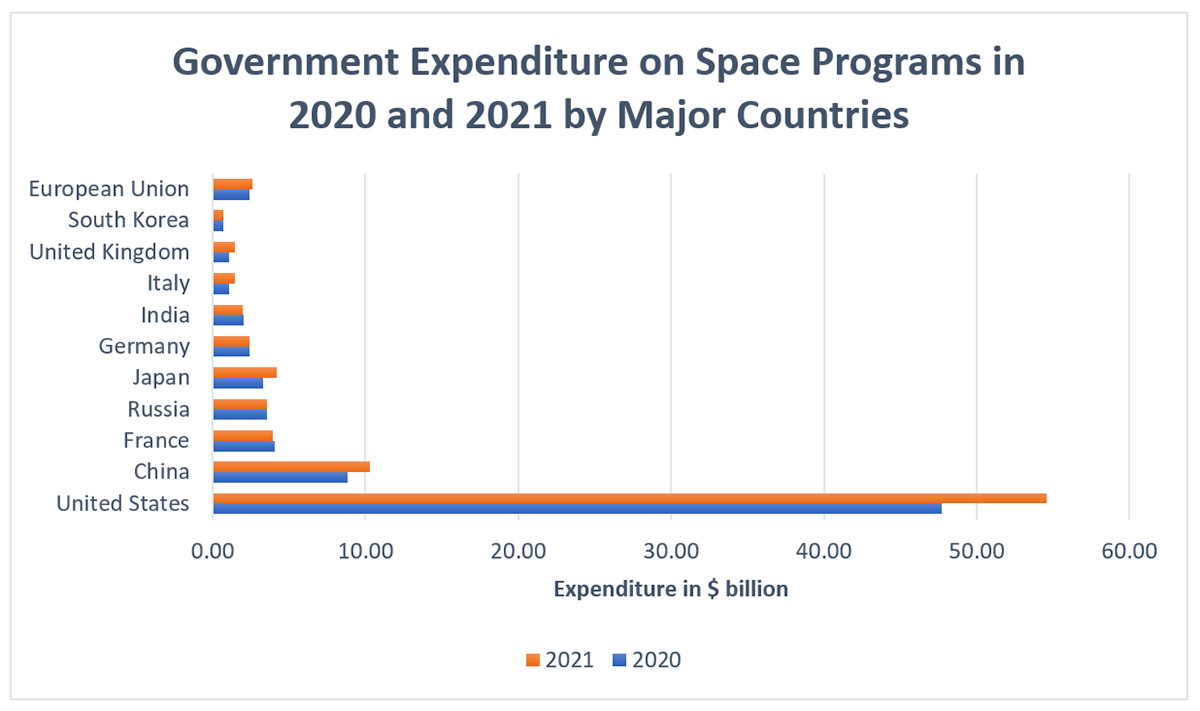
Still, the opportunities for space robotics to grow are huge. In fact, the market for space robotics could grow from $3.16 billion in 2023 to $4.75 billion in 2027, according to a report by Stratview Research.
Due to factors both economic and experiential, not many private-sector players have made significant progress in this field. Even so, some companies have made recent progress.
In November 2022, PickNik Robotics inked a deal with CisLunar Industries to explore how its software for robot arms could assist CisLunar with precision feeding of metal materials in the in-space metal processing solutions known as the Modular Space Foundry.
In April 2023, PickNik partnered with Motiv Space Systems, a designer and manufacturer of motion controllers and space robots, to co-develop systems for in-space servicing, assembly, and manufacturing.
In May 2023, Japan-based Gitai raised $30 million to enhance and accelerate the U.S. production of robots that will travel to space and help build a robust architecture.
Some key factors are contributing to the growth of the space robotics market.
Space exploration programs proliferate
2023 is the tentative launch year for more than 14 planetary events and missions by various space agencies, according to NASA. A similar number of missions is already set to launch in 2024.
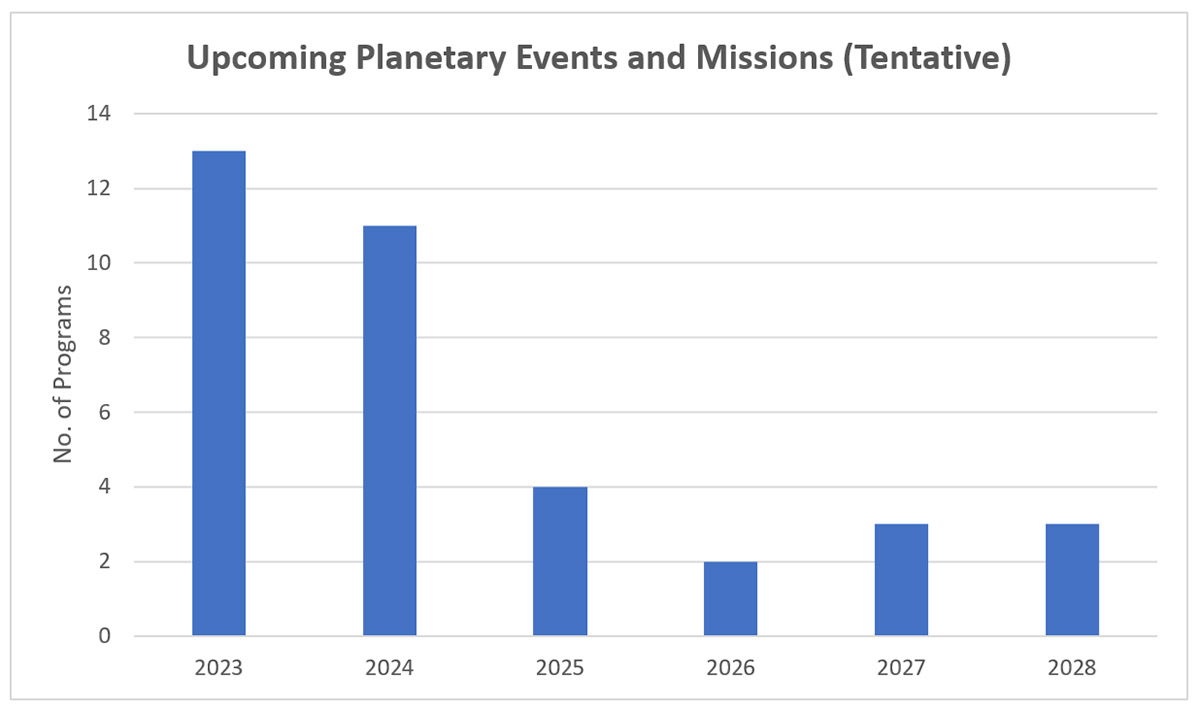
Once the current launches and missions are over, the space agencies will likely announce more such missions for the next terms, thus creating a continuous demand for space-related equipment and services, including robots.
The number of tentative launches after 2026 might seem a bit low, but as soon as the current programs are launched successfully, countries and companies will likely announce new programs with tentative launch dates after 2028.
In addition, top economies such as the U.S., China, and the European Union are increasing their space expenditures every year. Other players like France, Russia, Japan, Germany, and India are trying to come up with more efficient and economic ways of conducting space missions.
For instance, in November 2013, the Indian Space Research Organization (ISRO) successfully launched a Mars Orbiter with a mere expenditure of $74 million, making it the most economical Mars mission ever.
An endless space for robotics
Even though the oldest space agency—the Russian Federation Space Agency or RFSA, now ROSCOSMOS—was established around 100 years ago, humans have really only just begun to explore beyond Earth. Ever since the USSR's launch of Sputnik on Oct. 4, 1957, the thirst for exploring the mysteries of space has been unquenchable.
Human spaceflight has continued at a slower pace than during the Cold War competition, but robots offer ways to explore, prepare for eventual human follow-up, and extend our perception into the vast mysteries of space. There are endless opportunities for exploration.

About the author
Aniket Roy is an experienced technical writer with a passion for exploring and explaining the latest developments in aerospace industry.
Currently serving as a senior business analyst at Stratview Research, Roy has carved his niche in specific areas including aerospace. He is now creating content to help readers stay up to date with the latest trends and developments in his areas of expertise.
Article topics
Email Sign Up

